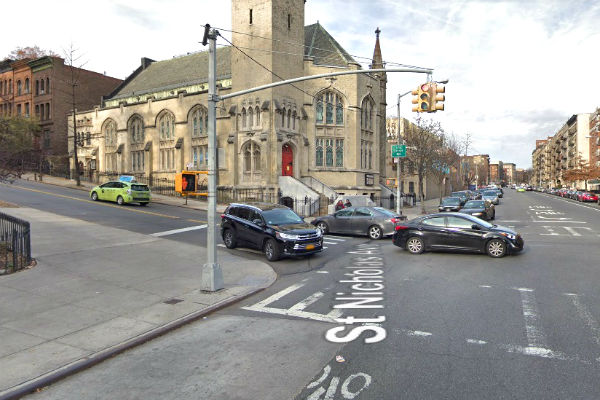 Fabulous Harlem brings you the best travel places in Harlem. Join us on a tour to experience one of Harlem’s most popular tourist destinations!
Fabulous Harlem brings you the best travel places in Harlem. Join us on a tour to experience one of Harlem’s most popular tourist destinations!
Join our Sugar Hill tour starting down 155th Street, a local favorite, only a few minutes from central Harlem. We’ll talk about the wonderful parks and the incredible history of the brownstones, and other long-loved histories of the neighborhood. We’ll read about the streets where musician BillyStrayhorn took “the A Train,” as we look nostalgically where Babe Ruth was an infant and where The Sugarhill Gang was America’s most wanted.
It is roughly bounded by West 155th Street to the north, West 145th Street to the south, Edgecombe Avenue to the east, and Amsterdam Avenue to the west. The equivalent New York City Historic Districts are:
- Hamilton Heights/Sugar Hill Historic District and Extension: roughly West 145th to West 150th Street, Edgecombe Avenue to between Convent and Amsterdam Avenues
- Hamilton Heights/Sugar Hill Northeast Historic District: roughly West 151st to West 155th Street, west of St. Nicholas Avenue to between Convent and Amsterdam Avenues
- Hamilton Heights/Sugar Hill Northwest Historic District: roughly West 151st to West 155th Street, east of St. Nicholas Avenue to Edgecombe Avenue
 The city districts were designated between 2000 and 2002, and the Federal district was listed on the National Register of Historic Places in 2002. The Federal district has 414 contributing buildings, two contributing sites, three contributing structures, and one contributing object.
The city districts were designated between 2000 and 2002, and the Federal district was listed on the National Register of Historic Places in 2002. The Federal district has 414 contributing buildings, two contributing sites, three contributing structures, and one contributing object.
Parks

Parks in the neighborhood include Jackie Robinson Park (pictured above), St. Nicholas Park, and smaller sites such as Johnny Hartman Square, Carmansville Playground, and William A. Harris Garden.
History

Sugar Hill got its name in the 1920s when the neighborhood became a popular place for wealthy African Americans to live during the Harlem Renaissance. Reflective of the “sweet life” there, Sugar Hill featured rowhouses in which lived such prominent African Americans as W. E. B. Du Bois, Thurgood Marshall, Adam Clayton Powell Jr., Duke Ellington, Cab Calloway, Walter Francis White, Roy Wilkins, and Afro-Rican Arturo Schomburg.
Langston Hughes wrote about the relative affluence of the neighborhood in his essay “Down Under in Harlem” published in The New Republic in 1944:
If you are white and are reading this vignette, don’t take it for granted that all Harlem is a slum. It isn’t. There are big apartment houses up on the hill, Sugar Hill, and up by City College — nice high-rent-houses with elevators and doormen, where Canada Lee lives, and W. C. Handy, and the George S. Schuylers, and the Walter Whites, where colored families send their babies to private kindergartens and their youngsters to Ethical Culture School.
Terry Mulligan’s 2012 memoir “Sugar Hill, Where the Sun Rose Over Harlem” is a chronicle of the writer’s experiences growing up in the 1950s and ’60s in the neighborhood, where her neighbors included future United States Supreme Court Justice Thurgood Marshall, early rock n’ roll legend Frankie Lymon, and New York baseball great Willie Mays, among other well-known names.
Notable Buildings

Among the many notable buildings in this incredible enclave in the Sugar Hill are:
- Nicholas C. and Agnes Benziger House, 345 Edgecombe Avenue (William Schickel, 1890–91) – has also been used as a hospital, nursery and housing for the homeless
- James A. and Ruth M. Bailey House, 10 St. Nicholas Place (Samuel B. Reed, 1886–88) – A Romanesque Revival residence built for James A. Bailey of the Barnum & Bailey Circus 14 and 16 St. Nicholas Place (William Grinnell, 1883–84) – Queen Anne style detached frame houses clad in wood shingles
- Fink House, 8 St. Nicholas Place (Richard S. Rosenstock, 1885) – Queen Anne style house, would later be combined with another building next door.
- Baiter House, 6 St. Nicholas Place (Theodore G. Stein, 1893–94) – …and used as a sanitarium, a hospital, a hotel, and a group home
- 713-721 St. Nicholas Avenue (Hugh M. Reynolds, 1890–91) – Row houses in the Victorian Romanesque Revival style
- 718-730 St. Nicholas Avenue (Arthur Bates Jennings, 1889–90) – A Romanesque Revival row
- 729 and 731 St. Nicholas Avenue (Theodore Minot Clark, 1886-86) – two houses faced in Manhattan schist and shingles
- 757-775 St. Nicholas Avenue (Frederick P. Dinkelberg, 1894–95) – A Renaissance Revival style row which is said to be “among the finest in the district.”
- 409 Edgecombe Avenue Apartments (Schwartz & Gross, 1916–17) – Originally the Colonial Parkway Apartments. Home to Babe Ruth as an infant, Thurgood Marshall, W. E. B. Du Bois, and Marvel Cooke.
In Popular Culture
- The Sugarhill Gang, the first rap group with a single in the Top 40, took their name from the neighborhood.
- The song Sugar Hill, a 1995 single by AZ.
- The 1994 film Sugar Hill, about drug dealers in Harlem, stars Wesley Snipes.
- Sugar Hill is mentioned in the lyrics to the jazz standard “Take the A Train” by BillyStrayhorn. It is also referred to by rapper AZ’s “Sugar Hill” on his album Doe or Die. Henry “Red” Allen recorded “Sugar Hill Function“, written by Charlie Holmes, on February 18, 1930. There is also a song by Rex Stewart and his Fifty-Second Street Stompers – one of the four Duke Ellington small groups – called “Sugar Hill Shim-Sham“, which was recorded on July 7, 1937.
The Google View

We love this real-time Google view here that gives a really great look at Sugar Hill from an on the ground view of the St. James Presbyterian Church (above) at St. Nicholas Avenue and 141st Street, Sugar Hill, Harlem, NY.
Things To Do & Other Stuff
- Sugar Hill Children’s Museum of Art & Storytelling, 898 St. Nicholas Avenue @ 155th Street, NY, 212.335.0004, www.sugarhillmuseum.org/, info@sugarhillmuseum.org
- Sugar Hill map, This walking tour map was designed with the desire to return a sense of appreciation and understanding to the Historic Harlem’s Sugar Hill community. www.sugarhillmap.com/
- Sugar Hill Creamery, Sugar Hill Creamery is Harlem’s only family-owned neighborhood ice cream shop, www.sugarhillcreamery.com/
- Sugar Hill: Where The Sun Rose Over Harlem, Book. Using Harlem’s cultural institutions and memorable characters as her backdrop, Mulligan writes joyously about weathering adolescence while history unfolds around her. Terry Baker Mulligan. $ 17.99
Check out our Facebook Page HERE for more details.
#FabulousHarlem, @FabulousHarlem, #HarlemWorldMagazine, @HarlemWorldMagazine
Photo credit: 1) Baily House. 2) St. Nicholas Place. 3) Jackie Robinson Park. 4) The Nicholas C. and Agnes Benziger House. 5) Fink House. 6) Google Screen shot. Adapted from source. Via Wikipedia.
Become a Harlem Insider!
By submitting this form, you are consenting to receive marketing emails from: . You can revoke your consent to receive emails at any time by using the SafeUnsubscribe® link, found at the bottom of every email. Emails are serviced by Constant Contact








